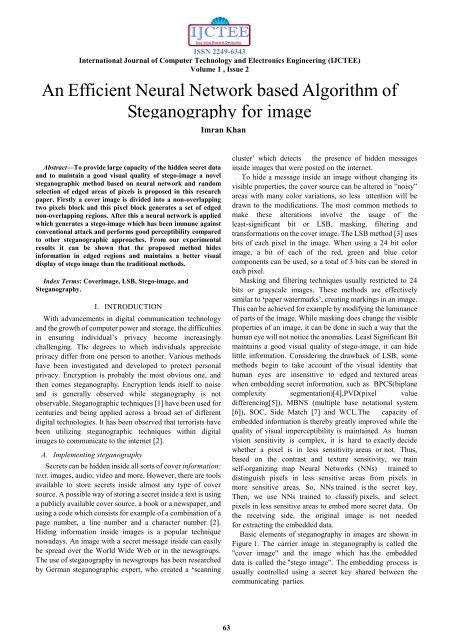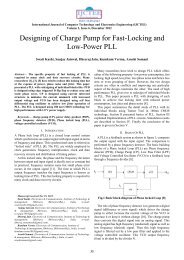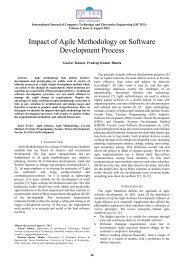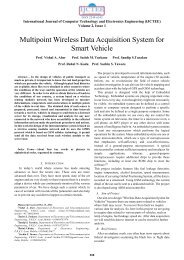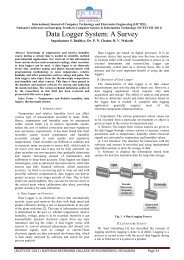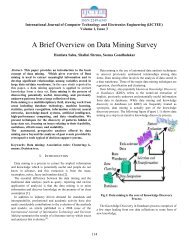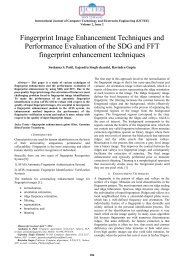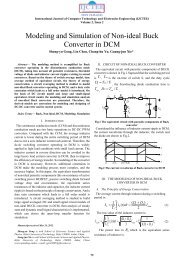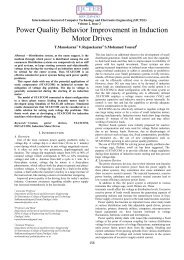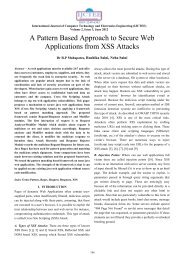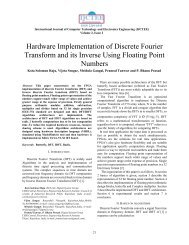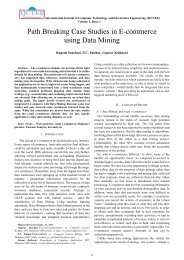An Efficient Neural Network based Algorithm of Steganography for ...
An Efficient Neural Network based Algorithm of Steganography for ...
An Efficient Neural Network based Algorithm of Steganography for ...
You also want an ePaper? Increase the reach of your titles
YUMPU automatically turns print PDFs into web optimized ePapers that Google loves.
ISSN 2249-6343<br />
International Journal <strong>of</strong> Computer Technology and Electronics Engineering (IJCTEE)<br />
Volume 1 , Issue 2<br />
<strong>An</strong> <strong>Efficient</strong> <strong>Neural</strong> <strong>Network</strong> <strong>based</strong> <strong>Algorithm</strong> <strong>of</strong><br />
<strong>Steganography</strong> <strong>for</strong> image<br />
Imran Khan<br />
<br />
Abstract—To provide large capacity <strong>of</strong> the hidden secret data<br />
and to maintain a good visual quality <strong>of</strong> stego-image a novel<br />
steganographic method <strong>based</strong> on neural network and random<br />
selection <strong>of</strong> edged areas <strong>of</strong> pixels is proposed in this research<br />
paper. Firstly a cover image is divided into a non-overlapping<br />
two pixels block and this pixel block generates a set <strong>of</strong> edged<br />
non-overlapping regions. After this a neural network is applied<br />
which generates a stego-image which has been immune against<br />
conventional attack and per<strong>for</strong>ms good perceptibility compared<br />
to other steganographic approaches. From our experimental<br />
results it can be shown that the proposed method hides<br />
in<strong>for</strong>mation in edged regions and maintains a better visual<br />
display <strong>of</strong> stego image than the traditional methods.<br />
Index Terms: Coverimage, LSB, Stego-image, and<br />
<strong>Steganography</strong>.<br />
I. INTRODUCTION<br />
With advancements in digital communication technology<br />
and the growth <strong>of</strong> computer power and storage, the difficulties<br />
in ensuring individual’s privacy become increasingly<br />
challenging. The degrees to which individuals appreciate<br />
privacy differ from one person to another. Various methods<br />
have been investigated and developed to protect personal<br />
privacy. Encryption is probably the most obvious one, and<br />
then comes steganography. Encryption lends itself to noise<br />
and is generally observed while steganography is not<br />
observable. Steganographic techniques [1] have been used <strong>for</strong><br />
centuries and being applied across a broad set <strong>of</strong> different<br />
digital technologies. It has been observed that terrorists have<br />
been utilizing steganographic techniques within digital<br />
images to communicate to the internet [2].<br />
A. Implementing steganography<br />
Secrets can be hidden inside all sorts <strong>of</strong> cover in<strong>for</strong>mation:<br />
text, images, audio, video and more. However, there are tools<br />
available to store secrets inside almost any type <strong>of</strong> cover<br />
source. A possible way <strong>of</strong> storing a secret inside a text is using<br />
a publicly available cover source, a book or a newspaper, and<br />
using a code which consists <strong>for</strong> example <strong>of</strong> a combination <strong>of</strong> a<br />
page number, a line number and a character number [2].<br />
Hiding in<strong>for</strong>mation inside images is a popular technique<br />
nowadays. <strong>An</strong> image with a secret message inside can easily<br />
be spread over the World Wide Web or in the newsgroups.<br />
The use <strong>of</strong> steganography in newsgroups has been researched<br />
by German steganographic expert, who created a ‘scanning<br />
cluster’ which detects the presence <strong>of</strong> hidden messages<br />
inside images that were posted on the internet.<br />
To hide a message inside an image without changing its<br />
visible properties, the cover source can be altered in ”noisy”<br />
areas with many color variations, so less attention will be<br />
drawn to the modifications. The most common methods to<br />
make these alterations involve the usage <strong>of</strong> the<br />
least-significant bit or LSB, masking, filtering and<br />
trans<strong>for</strong>mations on the cover image. The LSB method [3] uses<br />
bits <strong>of</strong> each pixel in the image. When using a 24 bit color<br />
image, a bit <strong>of</strong> each <strong>of</strong> the red, green and blue color<br />
components can be used, so a total <strong>of</strong> 3 bits can be stored in<br />
each pixel.<br />
Masking and filtering techniques usually restricted to 24<br />
bits or grayscale images. These methods are effectively<br />
similar to ‘paper watermarks’, creating markings in an image.<br />
This can be achieved <strong>for</strong> example by modifying the luminance<br />
<strong>of</strong> parts <strong>of</strong> the image. While masking does change the visible<br />
properties <strong>of</strong> an image, it can be done in such a way that the<br />
human eye will not notice the anomalies. Least Significant Bit<br />
maintains a good visual quality <strong>of</strong> stego-image, it can hide<br />
little in<strong>for</strong>mation. Considering the drawback <strong>of</strong> LSB, some<br />
methods begin to take account <strong>of</strong> the visual identity that<br />
human eyes are insensitive to edged and textured areas<br />
when embedding secret in<strong>for</strong>mation, such as BPCS(biplane<br />
complexity segmentation)[4],PVD(pixel value<br />
differencing[5]), MBNS (multiple base notational system<br />
[6]), SOC, Side Match [7] and WCL.The capacity <strong>of</strong><br />
embedded in<strong>for</strong>mation is thereby greatly improved while the<br />
quality <strong>of</strong> visual imperceptibility is maintained. As human<br />
vision sensitivity is complex, it is hard to exactly decide<br />
whether a pixel is in less sensitivity areas or not. Thus,<br />
<strong>based</strong> on the contrast and texture sensitivity, we train<br />
self-organizing map <strong>Neural</strong> <strong>Network</strong>s (NNs) trained to<br />
distinguish pixels in less sensitive areas from pixels in<br />
more sensitive areas. So, NNs trained is the secret key.<br />
Then, we use NNs trained to classify pixels, and select<br />
pixels in less sensitive areas to embed more secret data. On<br />
the receiving side, the original image is not needed<br />
<strong>for</strong> extracting the embedded data.<br />
Basic elements <strong>of</strong> steganography in images are shown in<br />
Figure 1. The carrier image in steganography is called the<br />
"cover image" and the image which has the embedded<br />
data is called the "stego image". The embedding process is<br />
usually controlled using a secret key shared between the<br />
communicating parties.<br />
63
ISSN 2249-6343<br />
International Journal <strong>of</strong> Computer Technology and Electronics Engineering (IJCTEE)<br />
Volume 1 , Issue 2<br />
This key ensures that only recipients who know the<br />
corresponding key will be able to extract the message from a<br />
stego image.<br />
Sabeti et. al [14] have successfully attacked basic PVD and<br />
the enhanced version <strong>of</strong> PVD.<br />
Table 1: Example <strong>of</strong> an image<br />
11 15 19<br />
12 13 18<br />
14 16 17<br />
Table 2: Vectorized image<br />
11 15 19 …. … 17<br />
Fig 1. Typical element <strong>of</strong> any steganographic system<br />
II. PIXEL VALUE DIFFERENCING METHOD<br />
A popular digital steganography technique is the so-called<br />
least significant bit (LSB) replacement. With the LSB<br />
replacement technique, the two parties in communication<br />
share a private secret key that key that creates a random<br />
sequence <strong>of</strong> samples <strong>of</strong> a digital signal. The encrypted<br />
secret message is embedded in the LSB's <strong>of</strong> those samples<br />
<strong>of</strong> the sequence. This digital steganography technique takes<br />
the advantage <strong>of</strong> random noise present in the acquired images<br />
[8]. Many reliable steganalytic methods have been devised<br />
<strong>for</strong> LSB flipping technique. The production <strong>of</strong> Pair <strong>of</strong><br />
Value (PoV) in the histogram <strong>of</strong> a stego image is the<br />
main weak point <strong>of</strong> the LSB flipping. The presence <strong>of</strong><br />
PoV has allowed many steganalysis methods, such as RS to<br />
successfully attack LSB flipping[10,11] .<br />
Wu and Tsai [12] presented a steganographic<br />
method <strong>based</strong> on Pixel Value Differencing (PVD). They<br />
divide the cover image into a number <strong>of</strong> non- overlapping<br />
two-pixel blocks. Each block is categorized according to the<br />
difference <strong>of</strong> the gray values <strong>of</strong> the two pixels in the block. A<br />
small difference value indicates that the block is in a<br />
smooth area and a large one indicates that it is in an<br />
edged area. The pixels in edged areas may tolerate larger<br />
changes <strong>of</strong> pixel values than those in the smooth areas.<br />
There<strong>for</strong>e, it is possible to embed more data in edged areas<br />
than in the smooth areas. All possible difference values<br />
are classified into a number <strong>of</strong> ranges. The number <strong>of</strong> bits<br />
that are to be embedded in a pixel pair depends on the<br />
width <strong>of</strong> the range that the difference value belongs to.<br />
PVD is immune against the attacks that scrutinize changes in<br />
spatial domain [11] or changes in the histogram [10].<br />
In [13] another method <strong>based</strong> on PVD is proposed which<br />
tries to increase the embedding capacity <strong>of</strong> PVD. In this<br />
version the image blocks are categorized <strong>based</strong> on the<br />
calculated pixel differences into two groups <strong>of</strong> smooth and<br />
edge. A block with difference less than a threshold is a<br />
smooth block; otherwise, it is an edge block. LSB embedding<br />
is used <strong>for</strong> smooth regions and PVD embedding <strong>for</strong> edged<br />
areas. We refer to this method as the enhanced PVD approach<br />
as opposed to the basic PVD approach discussed in [10].<br />
The cover images used in the PVD method are supposed to<br />
be 256 gray-valued ones. A difference value d is computed<br />
from every non-overlapping block <strong>of</strong> two consecutive pixels,<br />
say p i and p i+1 <strong>of</strong> a given cover image. Partitioning the<br />
cover image into two-pixel blocks runs through all the<br />
rows <strong>of</strong> each image in a zigzag manner. In Figure 2, an<br />
example <strong>of</strong> an image is shown. The two-pixel blocks that are<br />
constructed by zigzag scanning <strong>of</strong> the example image are<br />
shown in Figure 3.<br />
Assume that the gray values <strong>of</strong> p i and p i+1 are g i and g i+1 ,<br />
respectively; then d is computed as g i+1 -g i which may be a<br />
number ranging from -255 to 255.A block with d close to 0 is<br />
considered to be an extremely smooth block, where as a block<br />
with d close to -255 or 255 is considered as a sharply edged<br />
block. The method only considers the absolute values <strong>of</strong> d (0<br />
through 255) and classifies them into number <strong>of</strong> contiguous<br />
ranges, such as R k where k = 1, 2, …, q by l k and u k ,<br />
respectively, where l 1 is 0 and u q is 255.<br />
The width <strong>of</strong> R k (w k ) is u k - l k +1. In PVD method, the width<br />
<strong>of</strong> each interval is taken to be a power <strong>of</strong> 2.A practical set <strong>of</strong><br />
intervals may be: [0; 7]; [8; 15]; [16; 31]; [32; 63]; [64;<br />
127]; [128; 255].Every bit in the bit stream should be<br />
embedded into the two-pixel blocks <strong>of</strong> the cover image. Given<br />
a two-pixel block B with gray value difference d belonging to<br />
k th range, then n bits can be embedded in this block, and can<br />
be calculated by n = log(u k + l k + 1) which is an integer.<br />
A sub-stream S with n bits is selected next from the secret<br />
message <strong>for</strong> embedding in B. A new difference d’ then is<br />
computed by:<br />
Here b is the value <strong>of</strong> the sub-stream S. Because the value b<br />
is in the range from 0 to u k - l k , the value <strong>of</strong> d’ is in the range<br />
from l k to u k. If we replaced d with d’, the resulting changes<br />
are presumably unnoticeable to the observer. Then b can be<br />
embedded into pixels p i and p i+1 in a manner that the new pixel<br />
values produce a difference <strong>of</strong> d0.<br />
64
ISSN 2249-6343<br />
International Journal <strong>of</strong> Computer Technology and Electronics Engineering (IJCTEE)<br />
Volume 1 , Issue 2<br />
The new gray values (g’ i , g’ i+1 ) are obtained <strong>for</strong> the pixels<br />
in the to the corresponding two-pixel block (p’ I ,p’ i+1 ) <strong>of</strong> the<br />
stego-image. The embedding process is finished when all the<br />
bits <strong>of</strong> the secret message are embedded. The calculation <strong>for</strong><br />
computing (g’ i , g’ i+1 ) from the original gray values (g i , g i+1 ) <strong>of</strong><br />
the pixel pair is <strong>based</strong> on a function f((g i , g i+1 ),m) which is<br />
defined to be<br />
Once network weights are converged to certain values,<br />
proposed method use these values and the coordinates <strong>of</strong><br />
selected feature sub blocks as extraction keys. This extraction<br />
keys must be shared among the embedder and the extractor in<br />
order to extract proper hidden signals from the contents. First,<br />
frequency trans<strong>for</strong>mation <strong>of</strong> the image is per<strong>for</strong>med. Same<br />
amount <strong>of</strong> unique sub blocks as number <strong>of</strong> classification<br />
patterns must be chosen from the cover image. Sufficient<br />
number <strong>of</strong> neural networks must be prepared, which will be<br />
the number <strong>of</strong> binary digits to satisfy the classification<br />
patterns.<br />
Where m is d’- d. obviously embedding is only considered<br />
<strong>for</strong> pixels whose new pixel values would fall in the range <strong>of</strong><br />
[0,255].<br />
III. PROPOSED METHOD<br />
In this section, we explain how proposed method hides<br />
in<strong>for</strong>mation in stego-image and how we retrieve in<strong>for</strong>mation<br />
from the stego-image. With our method, the use <strong>of</strong> neural<br />
network is the key technique. Firstly a cover image is divided<br />
into a non-overlapping two pixels block and these pixel block<br />
generates a set <strong>of</strong> edged non-overlapping regions .All these<br />
blocks are generated by using PVD differencing<br />
method.Now,the embedder adjusts a neural network weights<br />
with desired hidden bit code from the collection <strong>of</strong> both cover<br />
image and stego-image folder(i.e. our training data). This<br />
pattern is common <strong>for</strong> both embedding and extracting the<br />
hidden in<strong>for</strong>mation. For learning we can use supervised<br />
learning <strong>of</strong> the neural network. By using XOR neural network<br />
learning model we embed the secret message within a cover<br />
image. At the first pixel location <strong>of</strong> stego image we embedded<br />
the message length and the edged pixel maps <strong>of</strong> a cover image<br />
A. In<strong>for</strong>mation hiding algorithm<br />
In the in<strong>for</strong>mation hiding algorithm firstly we generated a<br />
set <strong>of</strong> those pixels which are highly suited <strong>for</strong><br />
steganography.These pixels are generated by taking the pixel<br />
difference <strong>of</strong> two adjacent pixel block .This technique is<br />
described in section 2.Now in training, one must decide the<br />
structure <strong>of</strong> neural network. The amount <strong>of</strong> units <strong>for</strong> input<br />
layer is decided by the number <strong>of</strong> pixels selected from set <strong>of</strong><br />
edged region pixel map. In proposed method, the feature<br />
values are diagonal coefficient values from frequency<br />
trans<strong>for</strong>med selected feature sub blocks. For better<br />
approximation, one bias neuron is added <strong>for</strong> input layer. The<br />
neural network is trained to output a value <strong>of</strong> 1 or 0 as an<br />
output signal. In proposed method, one network represents<br />
one binary digit <strong>for</strong> corresponding secret codes.<br />
The adequate amount <strong>of</strong> neurons in the hidden layer, <strong>for</strong><br />
back propagation learning in general, is not known. So the<br />
number <strong>of</strong> neurons in hidden layer will be taken at will. In<br />
proposed method, six hidden units are used. For better<br />
approximation, one bias neuron like is introduced <strong>for</strong> hidden<br />
layer as well.<br />
Fig 2. Flow Chart <strong>of</strong> Proposed Method<br />
In case <strong>for</strong> 32 input patterns, five networks are enough to<br />
represent 32 different identification values because five<br />
binary digits are sufficient to distinguish <strong>for</strong> 32 patterns.<br />
Learning <strong>of</strong> all networks is repeated until the output value<br />
satisfies a certain learning threshold value. After all network<br />
weights are converged, the coordinates <strong>of</strong> sub blocks and the<br />
values <strong>of</strong> network weights are saved. Extractor will use this<br />
in<strong>for</strong>mation to extract hidden codes in the extraction process.<br />
B. Extraction algorithm<br />
Extraction process starts from the reading <strong>of</strong> stego-image<br />
and a extraction key in<strong>for</strong>mation. After providing this<br />
in<strong>for</strong>mation we calculate the total length <strong>of</strong> the message which<br />
will embed with a stego-image. We also retrieve the<br />
in<strong>for</strong>mation <strong>of</strong> edged region pixel set from stego-image. Only<br />
by knowing the proper coordinates <strong>of</strong> feature sub blocks will<br />
lead user to the proper input values. By knowing proper<br />
network weights, extractor can induce the structure <strong>of</strong> the<br />
network and only proper network weights are able to output<br />
65
ISSN 2249-6343<br />
International Journal <strong>of</strong> Computer Technology and Electronics Engineering (IJCTEE)<br />
Volume 1 , Issue 2<br />
the proper hidden codes. After constructing the neural<br />
network, extractor examines the output value from the<br />
network with the input values induced from the feature sub<br />
blocks. This procedure is shown in Figure 4. Each network<br />
output either 1 or 0 with the aid <strong>of</strong> threshold <strong>for</strong> output unit.<br />
The flow chart <strong>for</strong> calculation <strong>of</strong> extraction is given as<br />
Fig 3. Flow Chart <strong>for</strong> Calculation <strong>of</strong> extraction algorithm<br />
IV. IMPLEMENTATION AND MEASURES<br />
Dot net plat<strong>for</strong>m is chosen to develop the above<br />
steganographic algorithm. In a Dot net framework there are<br />
extensive libraries and efficient functions <strong>of</strong> neural network<br />
and image processing which is very useful in steganography.<br />
Developers may use other programming language<br />
also.Security, embedding distortion and embedding rate can<br />
be used as schemes to evaluate the per<strong>for</strong>mance <strong>of</strong> the data<br />
hiding schemes.<br />
A. Entropy<br />
A steganographic system is perfectly secure when the<br />
statistics <strong>of</strong> the cover data and the stego data are identical,<br />
which means that the relative entropy between the cover data<br />
and the stego-data is zero. Entropy considers the in<strong>for</strong>mation<br />
to be modeled as a probabilistic process that can be measured<br />
in a manner that agrees with intuition [14].The in<strong>for</strong>mation<br />
theory approach to steganography holds the systems’ capacity<br />
to be modeled as the ability to transfer in<strong>for</strong>mation. More<br />
in<strong>for</strong>mation regarding in<strong>for</strong>mation theory and its application<br />
to steganography can be found at [14].<br />
B. Mean Squared Error & SNR<br />
The (weighted) mean squared error between the cover<br />
image and the stego-image (embedding distortion) can be<br />
used as one <strong>of</strong> the measures to assess the relative<br />
perceptibility <strong>of</strong> the embedded text. Imperceptibility takes<br />
advantage <strong>of</strong> human psycho visual redundancy, which is very<br />
difficult to quantify. Mean square error (MSE) and Peak<br />
Signal to Noise Ratio (PSNR) can also be used as metrics to<br />
measure the degree <strong>of</strong> imperceptibility.<br />
MSE= [ M i=1 N j=1 ( f ij – g ij ) 2 ] MN<br />
PSNR=10 log 10 (L 2 / MSE)<br />
f ij is the pixel value from the cover image , g ij is the pixel<br />
value from the stego-image, and L is the peak signal value <strong>of</strong><br />
the cover image (<strong>for</strong> 8-bit images, L=255). Signal to noise<br />
ratio quantifies the imperceptibility, by regarding the message<br />
as the signal and the message as the noise. Thus, the higher the<br />
SNR, the more perceptible is the message.<br />
SNR = 2 S / 2 N<br />
C. Correlation<br />
Correlation is one <strong>of</strong> the best known methods that evaluate<br />
the degree <strong>of</strong> closeness between two functions. This measure<br />
can be used to determine the extent to which the original<br />
image and the stego-image are close to each other, even after<br />
embedding data Localization, that is detection <strong>of</strong> the presence<br />
<strong>of</strong> the hidden data relies on the use <strong>of</strong> cross correlation<br />
function R XY <strong>of</strong> two images X and Y, defined as[ 8],<br />
R XY ( , ) = i j X(i,y) Y(i-,j-)<br />
D. Ensuring Integrity-using Checksums<br />
In order to ensure the integrity <strong>of</strong> data and the cover<br />
medium, mechanisms should be employed that either detect<br />
that the medium has been altered or is able to withstand such<br />
changes and corrects them to the original state. Checksums<br />
could be used to alert the user <strong>of</strong> possible contamination or<br />
tampering. For monochrome images the application <strong>of</strong><br />
checksums is going to straight<strong>for</strong>ward with the checksums<br />
being calculated <strong>for</strong> the appropriate number <strong>of</strong> bits required to<br />
represent each <strong>of</strong> the pixels. For color images, the checksum<br />
scheme can be extended three times to the three-color planes.<br />
The checksum could also be calculated in a new coordinate<br />
system, <strong>for</strong> e.g., hue saturation intensity plane instead <strong>of</strong> RGB<br />
plane, and the resulting checksum could be embedded in the<br />
original coordinate plane.<br />
V. RESULT ANALYSIS<br />
In this experiment we used PNG and BMP images <strong>of</strong><br />
various resolutions as cover image. We train a set <strong>of</strong> 150<br />
images which is randomly taken from internet. These images<br />
have various memory sizes.<br />
Table 3: Dataset Taken <strong>for</strong> consideration<br />
proposed method LSB <strong>Steganography</strong><br />
COVER IMAGE PSNR PSNR<br />
Federar.bmp 39.93 29.67<br />
Beach.bmp 43.907 33.198<br />
lily.bmp 37.86 34.26<br />
LENA.BMP 30.16 28.95<br />
PEPPERS.PNG 47.88 38.7<br />
FLOWER.PNG 36.16 32.65<br />
66
ISSN 2249-6343<br />
International Journal <strong>of</strong> Computer Technology and Electronics Engineering (IJCTEE)<br />
Volume 1 , Issue 2<br />
By per<strong>for</strong>ming the comparison <strong>of</strong> the cover image and the<br />
stego-image <strong>of</strong> above two methods datasets we come to<br />
conclude that the perceptibility ratio <strong>of</strong> the proposed method<br />
is better than the LSB steganography technique.<br />
Fig.4.Per<strong>for</strong>mance analysis in terms <strong>of</strong> PSNR ratio<br />
VI. CONCLUSION AND FUTURE WORK<br />
Given the high degree <strong>of</strong> redundancy present in a digital<br />
representation <strong>of</strong> image, there has been an increased interest<br />
in using it <strong>for</strong> the purpose <strong>of</strong> steganography. The paper<br />
suggested how a selection <strong>of</strong> different portions <strong>of</strong> the images<br />
increased the chances <strong>of</strong> hiding data in a more effective way.<br />
This type <strong>of</strong> embedding also reduces the chances <strong>of</strong> detection<br />
<strong>of</strong> secret message. Variation <strong>of</strong> the LSB [8] insertion<br />
algorithm. This algorithm can be used <strong>for</strong> achieving better<br />
security and also improved covertness. However <strong>for</strong> the future<br />
work <strong>of</strong> this method, we recommend the secret message<br />
should be compressed or encoded be<strong>for</strong>e the hiding process<br />
takes place. This is important because in this way we will<br />
minimize the amount <strong>of</strong> in<strong>for</strong>mation that is sent, and hence<br />
minimizing the chance <strong>of</strong> degrading the image. At the same<br />
time results <strong>of</strong> steganalysis can be used to change or improve<br />
embedding techniques.<br />
REFERENCES<br />
[1] Liu Shaohui, Yao Hongxun, Gao Wen “<strong>Neural</strong> <strong>Network</strong> <strong>based</strong><br />
Steganalysis in Still Images” Proceedings <strong>of</strong> IEEE ICME 2003.<br />
[2] I.Aveibas, N.Memon, B.Sankur. “Steganalysis <strong>based</strong> on image quality<br />
metrics”. Multimedia Signal Processing, 2001 IEEE Fourth Workshop<br />
on , 2001 .<br />
[3] ZNeil F.Johnson and Sushhil Jajodia. “Steganalysis: The Investigation<br />
<strong>of</strong> Hidden In<strong>for</strong>mation”. Proceedings <strong>of</strong> the IEEE In<strong>for</strong>mation<br />
Technology Conference, Syracuse, New York, USA.1998.<br />
[4] R.Chandramouli and N. Memon, “<strong>An</strong>alysis <strong>of</strong> LSB <strong>based</strong> image<br />
steganography techniques,” in Proc. ICIP, Oct. 2001.<br />
[5] Chandramouli, M. Kharrazzi, and N. Memon Image steganography<br />
and steganalysis: Concepts and Practice ,Springer-Verlag, vol. 2939,<br />
2004.<br />
[6] Jessica Fridrich, Miroslav Goljan. Practical Steganalysis <strong>of</strong> Digital<br />
Images-State <strong>of</strong> the Art.<br />
[7] N.Provos and Peter Honeyman, “Detecting Steganographic content on<br />
the internet”,CITI Technical Report 01-11, 2001.<br />
[8] N.Provos,“Defending against statistical analysis”, 10th USENIX<br />
Security Symposium,Washington,DC,August 2001.<br />
[9] Xuefeng Wang and Yingjun Feng. A New Learning <strong>Algorithm</strong> <strong>for</strong><br />
<strong>Neural</strong> <strong>Network</strong>s. Journal <strong>of</strong> Harbi institute <strong>of</strong> technology.<br />
29(2):23-25.<br />
[10] Xuefeng Ying & jun Feng. A Fast Learning <strong>Algorithm</strong> <strong>of</strong> Multi-Layer<br />
<strong>Neural</strong> <strong>Network</strong>. OR Transactions. 5-9, 1998.<br />
[11] B. Chen and Wornell. Implementations <strong>of</strong> quantization index<br />
modulation methods <strong>for</strong> digita watermarking and in<strong>for</strong>mation<br />
embedding <strong>of</strong> multimedia. Special Issue on Multimedia Signal<br />
Processing, vol. 27:7-33, 2001.<br />
[12] Voloshynovskiy, S.,Herrigel and Rytsar Y. StegoWall: Blind<br />
statistical detection <strong>of</strong> hidden data. Proceedings <strong>of</strong> SPIE. Vol.<br />
4675:57-68.2002.<br />
[13] Shadrokh samavi,Vajiheh Sabeti,Mojtaba Mahadevi and Shahram<br />
Shirani. Steganalysis <strong>of</strong> embedding in difference <strong>of</strong> image pixel pairs<br />
by neural network. Journal <strong>of</strong> ISeCure, volume 1, pages 17-26, January<br />
2009.<br />
[14] Kensuke Naoe,Yoshiyasu Takefuji. Damageless In<strong>for</strong>mation Hiding<br />
using <strong>Neural</strong> <strong>Network</strong> on YCbCr Domain. IJCSNS Journal,volume<br />
8,pages 81-86,september 2008.<br />
[15] Mehdi Kharrazi,Husrev T. Sencar & Nasir Memon, Per<strong>for</strong>mance study<br />
<strong>of</strong> common image steganography and steganalysis techniques.IEEE<br />
Journal <strong>of</strong> Electronic Imaging 15(4), 041104 (Oct–Dec 2006).<br />
[16] WangYan & Ling-di Ping. A New <strong>Steganography</strong> <strong>Algorithm</strong> Base on<br />
Spatial Domain. Second International Symposium on In<strong>for</strong>mation<br />
1/09 IEEE.<br />
[17] Zhang Jiajia, Liu Jing & Deng Cheng1.A Steganographic Method<br />
<strong>based</strong> on SOM and wavelet contrast. IEEE International Conference on<br />
Artificial Intelligence and Computational Intelligence<br />
978-0-7695-3816-7/09 IEEE.<br />
[18] Sambasiva Rao, Baragada S. Ramakrishna,M. S. Rao & S.<br />
Purushothaman. Polynomial Discriminant Radial Basis Function <strong>for</strong><br />
Steganalysis. IJCSNS International Journal <strong>of</strong> Computer Science and<br />
<strong>Network</strong> Security, VOL.9 No.2,pages 209-218, February 2009.<br />
[19] Asha, A. In<strong>for</strong>mation hiding - The Art <strong>of</strong> <strong>Steganography</strong>, GSEC<br />
practical. SANS Institute, 2005.<br />
AUTHOR BIOGRAPHY<br />
Imran Khan received his Bachelor’s Degree in<br />
Computer Science & Engineering from Rajiv Gandhi<br />
Proudyogiki Vishwavidyalaya, Bhopal (M.P.)-India<br />
in year 2005 and M. Tech. (In<strong>for</strong>mation Technology)<br />
from Rajiv Gandhi Proudyogiki Vishwavidyalaya,<br />
Bhopal (M.P.)-India in year 2011. He is an Assistant<br />
Pr<strong>of</strong>essor in Oriental Institute <strong>of</strong> Science and<br />
Technology, Bhopal in the Department <strong>of</strong><br />
In<strong>for</strong>mation Technology. His research areas are<br />
neural network, artificial intelligence and network<br />
security. He is having six research papers in International and national<br />
Journals<br />
67


